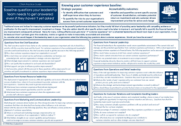In a previous article I reflected upon the decades of measuring customer experience that’s left the boardroom, and entire businesses, spending more time debating “what numbers to use” to measure customer experience, than “what actions to take” to improve it. In this article I want to close that gap by offering a set of questions that your leadership team needs to get answered - even if they haven’t yet asked. And indeed, if you are a member of the leadership team, these are the questions you should be asking.
Instead of discussing potentially abstract numbers like satisfaction, loyalty and advocacy scores, leadership teams must first measure customer experience in terms of its impact on strategic outcome objectives such as customer retention, positive referrals, revenue, profit, and cost containment. A leadership team using the dollar as their unit of customer satisfaction, combined with an actionable measurement methodology, will have the clarity needed to set reasoned priorities and justify investment in customer experience improvement initiatives.
If “customer experience” isn’t a scheduled leadership and board-room topic in your organisation, it may be because it hasn’t yet been given the vocabulary, metrics or agenda to make it measurable, accountable and actionable. So, consider what would happen if the leadership team in your organisation asked the following key questions about customer experiences. Would you have the answers?
Questions from the Chief Executive: “Strategic risks, threats and solutions”
Chief executives need to have clarity on why customer experience is important and why it should be a priority with the executive team and the board. For customer experience to have enduring and meaningful executive and board-level buy-in, the chief executive needs to get the answers to the following questions:
- How does customer experience impact our organisation’s success?
-
 How much does our current service performance
undermine our business,
our
How much does our current service performance
undermine our business,
our
potential growth, and our organisation’s strategic outcome objectives? - What strategic improvements to customers’ experiences are most urgent?
- How can I justify this investment to our board and shareholders?
- What support can I give to influence positive improvements?
A chief executive, armed with the answers to these questions, will be empowered to set priorities and justify investment in customer experience improvement.
Questions from Financial leadership: “Financial risks and returns”
The financial leadership in the organisation needs a more quantitative assessment of the current risks and damage, and the potential opportunities from improving customer experiences. With a robust approach to expressing customer experience in financial terms, the following questions can be answered:
-
 How much future revenue is at risk from
our current performance?
How much future revenue is at risk from
our current performance? - How much wasted costs arise from our current customer experience performance?
- What is our potential return on investment in service improvement?
Financial leadership driven by these key metrics will find it easy to support customer experience improvement initiatives and be well-placed to monitor the results they yield.

.png)
 But it’s not just the Chief Executive and Financial Leadership that
need to expect more clarity about customer experience. As you take
a look around the leadership table, passions often vary from enlightened customer champions through to
battle-weary sceptics.
But it’s not just the Chief Executive and Financial Leadership that
need to expect more clarity about customer experience. As you take
a look around the leadership table, passions often vary from enlightened customer champions through to
battle-weary sceptics. 
 Paul Linnell is a customer experience and service quality
improvement champion, working internationally with senior managers
and their teams to help them achieve business success, reduce risk
and build customer loyalty and advocacy by taking actions to improve
customer experiences. Paul specialises in the design and deployment
of customer experience measurement, service quality improvement,
complaints handling and preventive analysis programmes. Industries
he has worked with include, Automotive, Consumer electronics,
Consumer goods, Electricity & Gas retail, Financial services,
Information technology, Local Government and Public Sector, Media /
Publishing, Passenger travel (Rail, Air and Sea), Pharmaceuticals
and Telecommunication. Paul has worked with clients and presented on
these subject at conferences and corporate events in the UK, Europe,
North America, the Middle East, Australia and New Zealand.
Originally from the UK and now based in New Zealand, he continues to
serve clients globally.
Paul Linnell is a customer experience and service quality
improvement champion, working internationally with senior managers
and their teams to help them achieve business success, reduce risk
and build customer loyalty and advocacy by taking actions to improve
customer experiences. Paul specialises in the design and deployment
of customer experience measurement, service quality improvement,
complaints handling and preventive analysis programmes. Industries
he has worked with include, Automotive, Consumer electronics,
Consumer goods, Electricity & Gas retail, Financial services,
Information technology, Local Government and Public Sector, Media /
Publishing, Passenger travel (Rail, Air and Sea), Pharmaceuticals
and Telecommunication. Paul has worked with clients and presented on
these subject at conferences and corporate events in the UK, Europe,
North America, the Middle East, Australia and New Zealand.
Originally from the UK and now based in New Zealand, he continues to
serve clients globally.